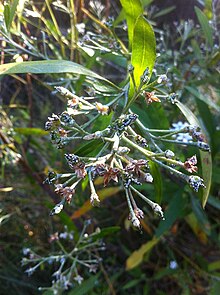
Phebalium whitei is a small shrub that is endemic to south-east Queensland. It has branchlets covered with silvery and rust-coloured scales, leathery, oblong to elliptic leaves and bright yellow flowers arranged in sessile umbels on the ends of branchlets.

Phebalium bullatum, commonly known as silvery phebalium, desert phebalium or sand phebalium, is a species of shrub that is endemic to southern continental Australia. It is more or less covered with silvery scales and has narrow oblong to narrow wedge-shaped leaves and yellow flowers in umbels of about six.

Petrophile biloba, commonly known as granite petrophile, is a species of flowering plant in the family Proteaceae and is endemic to southwestern Western Australia. It is a shrub with pinnately-divided leaves with sharply-pointed tips, and oval heads of hairy, mostly grey to pink flowers.

Leionema elatius, commonly known as tall phebalium, is a shrub species that is endemic to New South Wales and Queensland in Australia. It has glossy green, variably-shaped leaves and clusters of white-lemon flowers in spring.

Leionema phylicifolium, commonly known as alpine phebalium, is a shrub that is endemic to south-eastern Australia. It is a small shrub with green, smooth, leathery leaves and pale yellow flowers in spring.

Rhadinothamnus is a small genus of shrubs in the family Rutaceae. The genus, which is endemic to Western Australia, was formally described in 1971.

Crowea angustifolia is a flowering plant in the family Rutaceae, and is endemic to the south-west of Western Australia. It is an erect shrub growing to 3 m (10 ft) high by 1.0 m (3 ft) in diameter with white or pink flowers in spring.
Leionema equestre, commonly known as Kangaroo Island phebalium, is a shrub species that is endemic to South Australia. It is a small spreading shrub with rough, green leaves and whitish-pink flowers from late winter to October.

Leionema gracile, commonly known as Mt Greville phebalium, is a shrub species that is endemic to Queensland, Australia. It is a small shrub with spreading leaves, white petals and flowers from autumn to spring.
Leionema hillebrandii, commonly known as Mount Lofty phebalium, is a perennial, woody shrub endemic to South Australia. It has variable shaped leaves and pinkish flowers from late winter to spring.

Leionema montanum, is a small shrub with terminal clusters of white-pink flowers in upper leaf axils in spring. It is endemic to Tasmania.
Phebalium brevifolium is a species of small shrub that is endemic to Western Australia. It has warty branchlets, sessile, wedge-shaped leaves and up to three white flowers arranged in umbels.
Phebalium clavatum is a species of shrub that is endemic to Western Australia and is more or less covered with silvery scales. It has warty branchlets, more or less circular leaves with a large spherical gland and white flowers arranged singly on the ends of branchlets.
Phebalium elegans is a species of spreading shrub that is endemic to Western Australia. It has warty branchlets, wedge-shaped leaves and two to five white flowers arranged in umbels on the ends of branchlets.

Phebalium megaphyllum is a species of erect, rounded shrub that is endemic to Western Australia. It has glandular-warty branchlets, oblong to wedge-shaped leaves with a groove on the upper surface, and white flowers arranged in umbels of three to six on the ends of branchlets.
Phebalium microphyllum is a species of small, rounded shrub that is endemic to Western Australia. It has scaly branchlets, leathery, oblong leaves, and yellow flowers arranged in umbels of three to six on the ends of branchlets.
Phebalium obovatum is a species of spreading shrub that is endemic to Western Australia. It has thick, egg-shaped or elliptical leaves densely covered with silvery scales on the lower side and white flowers arranged in umbels with silvery or rust-coloured scales on the back.

Rhadinothamnus rudis is a small shrub with needle-shaped, angular branchlets and single white flowers at the end of branches. This species and the three subspecies are endemic to Western Australia.

Commersonia apella, commonly known as many-flowered commersonia, is a small, upright shrub in the family Malvaceae and is endemic to Western Australia. It has hairy leaves and whitish flowers.

Thomasia macrocalyx is a species of flowering plant in the family Malvaceae and is endemic to the south-west of Western Australia. It is an erect, bushy shrub with densely hairy new growth, egg-shaped leaves with a heart-shaped base and lobed or toothed edges, and groups of pale purple to mauve or white flowers.














